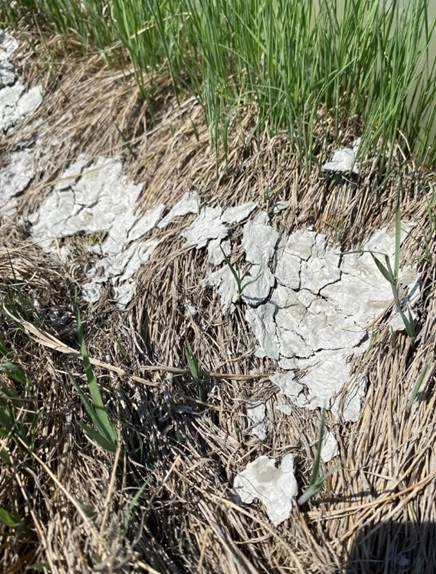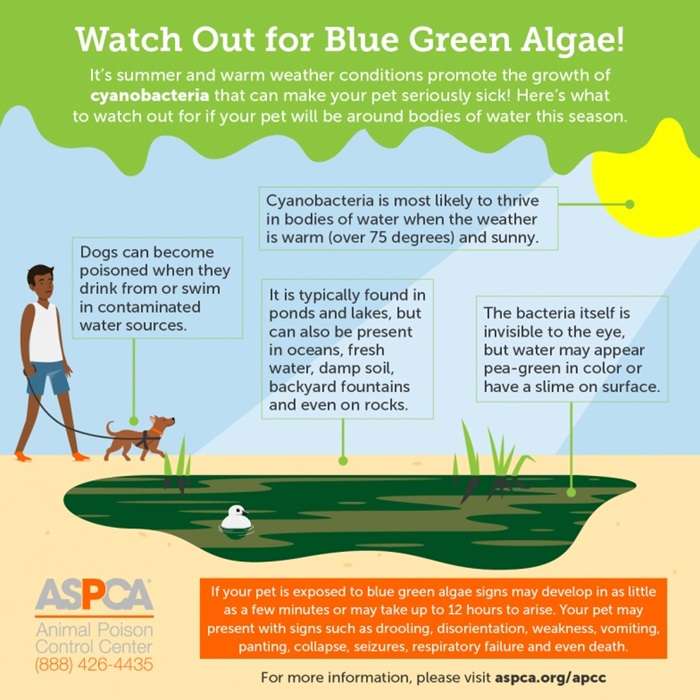
Key points:
- Blue-green algae is actually cyanobacteria that clumps together and looks like algae.
- Found in and around bodies of water during or shortly after hot, sunny weather.
- Can be clumps of blue, green, yellow, brown, or red -- OR -- can look like paint floating on the water.
- Dogs playing in or drinking affected water can become sick very quickly and can die.
As pet owners, we want to give our dogs the best possible care. However, sometimes even our best efforts can't protect them from hidden dangers.
One such danger that's becoming more common is blue-green algae, which produces toxins that are deadly to dogs.
What is Blue-Green algae?
They are a type of bacteria found in bodies of water, such as ponds, lakes, rivers, and even saltwater. It's found throughout the world, generally when the weather is warm and sunny (or has been recently).
Usually blue-green in color, it can form dense mats, called blooms, on the water's surface. These blooms can range in size from small patches to covering entire lakes. Or it can look shiny, oily, or like paint floating on the water.
Swimming or playing in contaminated water can cause hay fever-like symptoms, skin rashes, and respiratory and digestive distress. Drinking water contaminated with a high concentration of blue-green algae could cause liver and kidney damage. Symptoms often begin within hours.
Even short-term exposure can cause acute illnesses in people and dogs.
The dangers of blue-green algae for dogs
Dogs are generally more at risk, as they like to play and swim in the water and even drink it. Playing fetch in affected water can be twice as dangerous as the toxins may be swallowed and on the body.
Symptoms can appear within minutes of exposure, and can include:
- vomiting
- diarrhea
- weakness
- difficulty breathing
- seizures
- death
If your dog has been exposed to blue-green algae, it's important to act quickly. Call your vet and describe any symptoms your dog has. If possible, bring a sample of the water with you to the vet to help with diagnosis and treatment.
Identifying blue-green algae
Although it can sometimes be hard to identify, tell-tale signs include:
- water that looks like pea soup, green paint, or blue-green scum
- foam or bubbles on the surface of the water
- clumps or mats on the water or along the shoreline
- a musty or earthy smell
If you think there's blue-green algae in a body of water, keep your dog away from the water.
Test kits are available and testing can be done on-site with results in about 15 minutes. Amazon usually has these kits for about $25. Be sure to use waterproof gloves when collecting a sample. Nitrile exam gloves are readily available online or at a local pharmacy.
More dangers
Although swimming in or drinking affected water is the most common cause of illness, it's not the only cause.
Recently a professional trainer was working the dogs in his care and when finished he let them all out to play. Several of the dogs stopped to eat something on the bank of a pond. The trainer thought it was goose poop because there were geese in the area.
That evening some of the dogs became ill. Despite veterinary care over the course of several days, six of the dogs died. Necropsies determined the dogs died from eating toxic algae. Most of the dogs were preparing to compete in field trails and were owned by the trainer's clients.

Photo provided by Utah Division of Water Quality
Protect your dog from exposure
The best way to protect your dog from blue-green algae is to prevent exposure in the first place. Here are some things to keep in mind:
- Check for local advisories.
- Many states have websites that post advisories about blue-green algae outbreaks in local bodies of water.
- If you're not sure about the safety of a body of water, keep your dog on a leash and away from the water.
- Blue-green algae thrive in stagnant water, so it's best to avoid ponds or lakes that don't have a lot of circulation.
- Be vigilant.
- Watch your dog closely for any symptoms when they are swimming or playing in the water. If you see any of the symptoms listed above, contact your veterinarian immediately.
Quick Reminder
Blue-green algae often grows in ponds and lakes when the weather has been warm and sunny. The toxins it produces can be deadly to dogs.
Check for clumps of blue-green algae in the water or along the shoreline. Sometimes it will look shiny, oily, or like paint floating on the water. If you're not sure, keep your dog out of the water.
Test kits are available and only take about 15 minutes for results.
If your dog goes in or drinks any water that you suspect has blue-green algae, contact your veterinarian immediately for advice.
Be aware of the health risks and take precautions to reduce your dog's exposure to contaminated water. Keep your dog safe and healthy so they can enjoy the outdoors.

Header image courtesy California Waterboards - https://www.waterboards.ca.gov/
NOTE: The information on this website is not intended to replace your veterinarian's advice. This information is intended to provide non-technical information in an easy-to-understand format. The website author accepts no responsibility or liability for how this information may be interpreted or construed, or any actions that might be taken as a result of the information herein.


